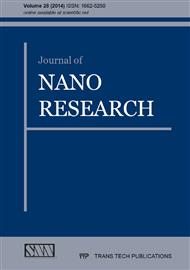[1]
Lewis NS, Crabtree GW, Nozik AJ, Wasielewski MR, Alivisatos AP (2005) Basic Energy Sciences Report on Basic Research Needs for Solar Energy Utilization. Office of Science, US Department of Energy 18–21.
DOI: 10.2172/899136
Google Scholar
[2]
Dresselhaus MS, Thomas IL (2001) Alternative Energy Technologies. Nature 414: 332.
Google Scholar
[3]
Crabtree GW, Dresselhaus MS, Buchanan MV (2004) The Hydrogen Economy. Phys. Today 57: 39.
Google Scholar
[4]
O'Regan B, Grätzel M (1991) A low-cost, high-efficiency solar cell based on dye-sensitized colloidal TiO2 films. Nature 353: 737.
DOI: 10.1038/353737a0
Google Scholar
[5]
Grätzel M (2001) Review article Photoelectrochemical cells. Nature 414: 338.
Google Scholar
[6]
Grätzel M (2005) Solar Energy Conversion by Dye-Sensitized Photovoltaic Cells. Inorg. Chem. 44: 6841.
DOI: 10.1021/ic0508371
Google Scholar
[7]
Chiba Y, Islam A, Watanabe Y, Komiya R, Koide N, Han L (2006) Dye-Sensitized Solar Cells with Conversion Efficiency of 11.1 %.Jpn. J. Appl. Phys. 25: 638.
DOI: 10.1143/jjap.45.l638
Google Scholar
[8]
Flahaut E, Peigney A, Laurent C, Marliere C, Chastel F, Rousset A (2000) Carbon nanotube-metal-oxide nanocomposites: microstructure, electrical conductivity and mechanical properties. Acta Mater. 48: 3803–3812.
DOI: 10.1016/s1359-6454(00)00147-6
Google Scholar
[9]
Peng C, Snook GA, Fray DJ, Shaffer MS, Chen GZ (2006) Carbon nanotube stabilised emulsions for electrochemical synthesis of porous nanocomposite coatings of poly[3,4-ethylene-dioxythiophene]. Chem. Commu. 44: 4629–4631.
DOI: 10.1039/b609293d
Google Scholar
[10]
Kongkanand A, Domı´nguezRM, Kamat PV (2007) Single wall carbon nanotube scaffolds for photoelectrochemical solar cells. Nano Lett. 7: 676–680.
DOI: 10.1021/nl0627238
Google Scholar
[11]
Miller AJ, Hatton RA, Silva SRP (2006) Interpenetrating multiwall carbon nanotube electrodes for organic solar cells. Appl. Phys. Lett. 89: 1331171–1331173.
DOI: 10.1063/1.2357844
Google Scholar
[12]
Lee TY, Alegaonkar PS, Yoo JB (2007) Fabrication of dye sensitized solar cell using TiO2 coated carbon nanotubes. Thin Solid Films 515: 5131–5135.
DOI: 10.1016/j.tsf.2006.10.056
Google Scholar
[13]
Kim SL, Jang SR, Vittal R, Lee J, Kim KJ (2006) Rutile TiO2-modified multi-wall carbon nanotubes in TiO2 film electrodes for dye-sensitized solar cells. J. Appl. Electrochem. 36: 1433–1439.
DOI: 10.1007/s10800-006-9238-4
Google Scholar
[14]
Heimer TA, Heilweil EJ, Bignozzi CA, Meyer GJ (2000) Electron Injection, Recombination and Halide Oxidation Dynamics at Dye-sensitized TiO2 Interfaces. J. Phys. Chem. A 18: 4256–4262.
DOI: 10.1021/jp993438y
Google Scholar
[15]
Kamat V, Haria M, Hotchandani S (2004) C60 Cluster as an Electron Shuttle in a Ru(II)-Polypyridyl Sensitizer Based Photochemical Solar Cell. J. Phys. Chem. B. 108: 5166–5170.
DOI: 10.1021/jp0496699
Google Scholar
[16]
Chang H, Hsieh TJ, Chen TL, Huang KD, Jwo CS, Chien SH (2009) Dye-Sensitized Solar Cells Made with TiO2-Coated Multi-Wall Carbon Nanotubes and Natural Dyes Extracted from Ipomoea. Materials Transactions. 50: 2879-2884.
DOI: 10.2320/matertrans.m2009203
Google Scholar
[17]
Kao MC (2011) Effect of annealing temperature of TiO2 thin films for application in dye-sensitized solar cells. Hsiuping Journal 125-134.
Google Scholar
[18]
Kan Z, Feng JZ, Ming LC, Won CO (2011) Comparison of catalytic activities for photocatalytic and sonocatalytic degradation of methylene blue in present of anatase TiO2–CNT catalysts. UltrasonicsSonochemistry18: 765–772.
DOI: 10.1016/j.ultsonch.2010.11.008
Google Scholar
[19]
Yu Y, Yu JC, Yu JG, Kwok YC, Che YK, Zhao JC, Ding L, Ge WK, Wong PK (2005) Enhancement of photocatalytic activity of mesoporous TiO2 by using carbon nanotubes. Appl. Catalysis A: General289-186.
DOI: 10.1016/j.apcata.2005.04.057
Google Scholar
[20]
Abdullah H, Ariyanto NP, Shaari S, Yuliarto B, Junaidi S (2009) Study of Porous Nanoflake ZnO for Dye-Sensitized Solar Cell Application. American J of Engineering and Applied Science 2 1: 236-240.
DOI: 10.3844/ajeas.2009.236.240
Google Scholar
[21]
Yu Y, Ma LL, Huang WY, Du FP, Yu JC, Yu JG, Wang JB, Wong PK (2005) Sonication assisted deposition of Cu2O nanoparticles on multiwall carbon nanotubes with polyol process. Carbon43: 651.
DOI: 10.1016/j.carbon.2004.10.031
Google Scholar
[22]
Lee KM, Suryanarayanan V, Huang JH, Justin Thomas KR, Lin JT, Ho KC (2009) Enhancing the Performance of Dye-sensitized Solar Cells based on an Organic Dye by Incorporating TiO2 Nanotube in a TiO2 Nanoparticle Film. Electrochim. Acta. 54: 4123.
DOI: 10.1016/j.electacta.2009.02.052
Google Scholar
[23]
Wang TT, Raghunath P, Lu YF, Liu YC, Chiou CH, Lin MC (2011) Observation of Significant enhancement in the efficiency of a DSSC by InN nanoparticles over TiO2-nanoparticle films. Chemical Physics Letters 510: 126–130.
DOI: 10.1016/j.cplett.2011.05.020
Google Scholar
[24]
Wen P, Han Y, Zhao W (2012) Influence of TiO2Nanocrystals Fabricating Dye-Sensitized Solar Cell on the Absorption Spectra of N719 Sensitizer. International Journal of Photoenergy 2012: 7.
DOI: 10.1155/2012/906198
Google Scholar
[25]
Chang H, Hsieh TJ, Chen TL, Huang KD, Jwo CS, Chien SH (2009) Dye-Sensitized Solar Cells Made with TiO2-Coated Multi-Wall Carbon Nanotubes and Natural Dyes Extracted from Ipomoea. Materials Transactions 50: 2879-2884.
DOI: 10.2320/matertrans.m2009203
Google Scholar
[26]
Fabregat-Santiago F, Bisquert J, Garcia-Belmonte G, Boschloo G, Hagfeldt A (2005) Influence of electrolyte in transport and recombination in dye-sensitized solar cells studied by impedance spectroscopy. Sol. Energy Mater. Sol. Cells. 87: 117–131.
DOI: 10.1016/j.solmat.2004.07.017
Google Scholar
[27]
Zen S, Teramoto Y, Ono R, Oda T (2012) Development of low-temperature sintering technique fordye-sensitized solar cells combined with dielectric barrier discharge treatment. Jpn. J. Appl. Phys 51: 056201.
DOI: 10.7567/jjap.51.056201
Google Scholar
[28]
Winantyo R, Zulfia A, Poespawati NR, Hartanto D (2011) Effect of Annealing on Characterization of TiO2-Based DSSC. Journal of Materials Science and Engineering A 2 2: 232-237.
Google Scholar


